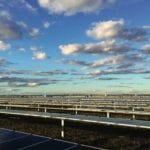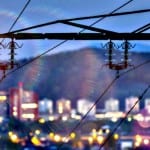Around The Web
Quebec may face carbon unit deficit as fuel emissions continue to rise
Ozone layer finally healing after damage caused by aerosols, UN says
Upper layer above northern hemisphere should be completely repaired in 2030s
The ozone layer is showing signs of continuing recovery from man-made damage and is likely to heal fully by 2060, new evidence shows.
The measures taken to repair the damage will also have an important beneficial effect on climate change, as some of the gases that caused the ozone layer to thin and in places disappear also contribute to warming the atmosphere. Phasing them out could avoid as much as 0.5C (0.9F) of warming this century.
Continue reading...Why do vegans have such bad reputations?
Brussels urges EU states to “file difference” to UN’s CORSIA aviation scheme
EU Market: EUAs hold above €17 following weak auction
Sighting of sperm whales in Arctic a sign of changing ecosystem, say scientists
Rare sighting in the Canadian Arctic leads to concern they could become trapped as winter approaches
A rare sighting of sperm whales in the Canadian Arctic is the latest sign of a quickly changing ecosystem, say scientists.
Brandon Laforest, a marine biologist with the World Wildlife Fund, and guide Titus Allooloo were working on a project monitoring the effect of marine traffic on the region’s narwhal population when they spotted the pair of large whales just outside Pond Inlet, a community at the northern tip of Baffin Island in September.
Continue reading...Aviation industry urges governments to wait to set a global GHG target
Dinosaur world 'more colourful than we thought'
ICIS adds to analyst roster with EU ETS veteran hire
Environment department accused of Brexit ‘panic’ after urgent staff demand
Leaked memo shows managers were given 24 hours to name 75 staff to be redeployed to work on a no-deal scenario
The environment department has been accused of “panic” over Brexit after a leaked document revealed the emergency redeployment of staff to prepare for a no-deal scenario.
Managers at the Environment Agency (EA) were given just 24 hours to name 75 staff to be sent to the Department of Environment, Food and Rural Affairs (Defra). In September, the National Audit Office said Michael Gove’s department will not be ready for a no-deal Brexit, with meat and dairy and chemicals exports especially threatened.
Continue reading...FRV’s Goonumbla solar farm lands deal with Snowy Hydro
 Spanish renewable energy developer FRV says Goonumbla solar project in NSW was one of the eight winning bids in the tender held by Snowy Hydro.
Spanish renewable energy developer FRV says Goonumbla solar project in NSW was one of the eight winning bids in the tender held by Snowy Hydro.
The post FRV’s Goonumbla solar farm lands deal with Snowy Hydro appeared first on RenewEconomy.
Revealed: The secret of the poet's daffodil
Indonesia economy ministry eyes 2021 start for carbon pricing mechanism
Tesla ute, electric semi, next-gen Roadster… and VTOL jet! Musk’s big EV ideas
 Tesla's Musk talks about the projects that really excite him - like the Tesla ute and the latest Roadster which he says will be best sports car "in every dimension."
Tesla's Musk talks about the projects that really excite him - like the Tesla ute and the latest Roadster which he says will be best sports car "in every dimension."
The post Tesla ute, electric semi, next-gen Roadster… and VTOL jet! Musk’s big EV ideas appeared first on RenewEconomy.
Millennials lead push to drive electric, says Jaguar
 Survey commissioned by Jaguar Land Rover shows nearly 50% of young Australians would like to buy an electric car over an ICE vehicle.
Survey commissioned by Jaguar Land Rover shows nearly 50% of young Australians would like to buy an electric car over an ICE vehicle.
The post Millennials lead push to drive electric, says Jaguar appeared first on RenewEconomy.
Ford and Volvo team with Baidu in China autonomous vehicle push
 Chinese internet giant signs agreement global carmakers Volvo and Ford to help put China at the centre of a massive autonomous electric car market push.
Chinese internet giant signs agreement global carmakers Volvo and Ford to help put China at the centre of a massive autonomous electric car market push.
The post Ford and Volvo team with Baidu in China autonomous vehicle push appeared first on RenewEconomy.
Solar roof tech tipped to power Hyundai and Kia EVs by 2019
 Hyundai and Kia look to add solar cells to the roofs of their cars to boost charging and range for EVs and hybrids.
Hyundai and Kia look to add solar cells to the roofs of their cars to boost charging and range for EVs and hybrids.
The post Solar roof tech tipped to power Hyundai and Kia EVs by 2019 appeared first on RenewEconomy.
Lion poaching: the brutal new threat to Africa’s prides
The big cats are horribly easy to kill with poisoned meat, allowing poachers to hack off their faces and paws – but rangers are now on their trail
• Warning: this article includes graphic images some readers may find disturbing
“That’s fresh, just a few hours old,” says Kris Everatt, pointing at a clear print of a lion’s paw in the hot dust. “It’s the ghost pride.”
The print is female. A bigger male print is soon spotted, also leading towards a precious water hole, then a smaller one. “A cub, less than two years old,” he says.
Continue reading...Air pollution: everything you should know about a public health emergency
It isn’t just car fumes that fill our urban centres with particles. Why is air pollution on the rise, who does it affect most – and what can we do about it?
Nothing is more vital to life than breathing: in a lifetime, about 250m litres of air passes through your lungs. Yet walk along a busy city street and you will inhale something like 20m particles in a single lungful.
Continue reading...Know your NEM: Coal comfort for electricity prices?
 Of all this week's stats, the fall in the coal price really stood out. So what's behind it, and what does it mean for Australia?
Of all this week's stats, the fall in the coal price really stood out. So what's behind it, and what does it mean for Australia?
The post Know your NEM: Coal comfort for electricity prices? appeared first on RenewEconomy.



